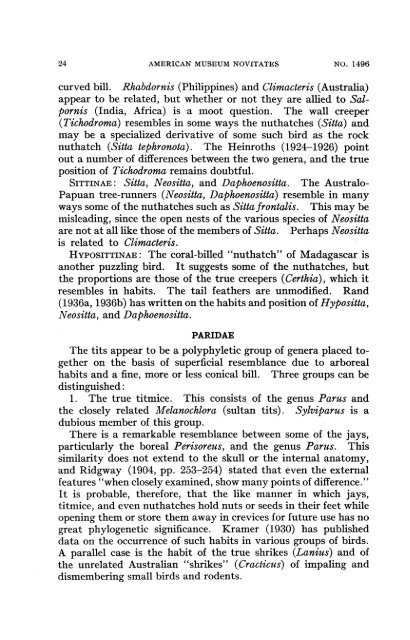NOVITATES - American Museum of Natural History
NOVITATES - American Museum of Natural History
NOVITATES - American Museum of Natural History
Create successful ePaper yourself
Turn your PDF publications into a flip-book with our unique Google optimized e-Paper software.
24 AMERICAN MUSEUM <strong>NOVITATES</strong> NO. 1496<br />
curved bill. Rhabdornis (Philippines) and Climacteris (Australia)<br />
appear to be related, but whether or not they are allied to Salpornis<br />
(India, Africa) is a moot question. The wall creeper<br />
(Tichodroma) resembles in some ways the nuthatches (Sitta) and<br />
may be a specialized derivative <strong>of</strong> some such bird as the rock<br />
nuthatch (Sitta tephronota). The Heinroths (1924-1926) point<br />
out a number <strong>of</strong> differences between the two genera, and the true<br />
position <strong>of</strong> Tichodroma remains doubtful.<br />
SITTINAE: Sitta, Neositta, and Daphoenositta. The Australo-<br />
Papuan tree-runners (Neositta, Daphoenositta) resemble in many<br />
ways some <strong>of</strong> the nuthatches such as Sittafrontalis. This may be<br />
misleading, since the open nests <strong>of</strong> the various species <strong>of</strong> Neositta<br />
are not at all like those <strong>of</strong> the members <strong>of</strong> Sitta. Perhaps Neositta<br />
is related to Climacteris.<br />
HYPOSITTINAE: The coral-billed "nuthatch" <strong>of</strong> Madagascar is<br />
another puzzling bird. It suggests some <strong>of</strong> the nuthatches, but<br />
the proportions are those <strong>of</strong> the true creepers (Certhia), which it<br />
resembles in habits. The tail feathers are unmodified. Rand<br />
(1936a, 1936b) has written on the habits and position <strong>of</strong> Hypositta,<br />
Neositta, and Daphoenositta.<br />
PARIDAE<br />
The tits appear to be a polyphyletic group <strong>of</strong> genera placed together<br />
on the basis <strong>of</strong> superficial resemblance due to arboreal<br />
habits and a-fine, more or less conical bill. Three groups can be<br />
distinguished:<br />
1. The true titmice. This consists <strong>of</strong> the genus Parus and<br />
the closely related Melanochlora (sultan tits). Sylviparus is a<br />
dubious member <strong>of</strong> this group.<br />
There is a remarkable resemblance between some <strong>of</strong> the jays,<br />
particularly the boreal Perisoreus, and the genus Parus. This<br />
similarity does not extend to the skull or the internal anatomy,<br />
and Ridgway (1904, pp. 253-254) stated that even the external<br />
features "when closely examined, show many points <strong>of</strong> difference."<br />
It is probable, therefore, that the like manner in which jays,<br />
titmice, and even nuthatches hold nuts or seeds in their feet while<br />
opening them or store them away in crevices for future use has no<br />
great phylogenetic significance. Kramer (1930) has published<br />
data on the occurrence <strong>of</strong> such habits in various groups <strong>of</strong> birds.<br />
A parallel case is the habit <strong>of</strong> the true shrikes (Lanius) and <strong>of</strong><br />
the unrelated Australian "shrikes" (Cracticus) <strong>of</strong> impaling and<br />
dismembering small birds and rodents.

















